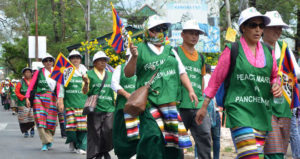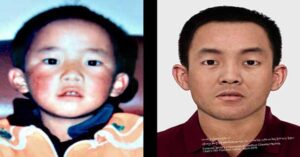The 11th Panchen Lama Gedhun Choekyi Nyima’s 30th birthday was on April 25. Twenty-four years ago, on the May 14, 1995, Gedhun Choekyi Nyima was recognised by His Holiness the 14th Dalai Lama as the reincarnation of the Panchen Lama. Three days later, the six-year-old and his family were abducted by the Chinese government and have not been seen since. His birthday was commemorated with events throughout India and the world, including peace marches, a bike rally, 30th birth anniversary functions and an unveiling of a forensic image on the BBC revealing an approximation of what the 11th Panchen Lama would look like today.
The Panchen Lama follows only the Dalai Lama in spiritual standing. One of the primary responsibilities of the Panchen Lama is to help in the recognition of the reincarnation of the Dalai Lama. The Chinese government came out with their own “Panchen Lama” with the hopes of fully controlling who is recognised as the reincarnation of the Dalai Lama, and furthering their control over Tibet.
The 11th Panchen Lama was the youngest political prisoner at the time of his abduction and has since become one of the world’s longest serving political prisoners. The whereabouts of him and his family are unknown, though information regarding them has been requested throughout the years by Tibetan leaders, human rights organisations, governments worldwide and United Nations human rights agencies.
To honour the 30th birthday of the Panchen Lama and highlight the situation between Tibet and China, the Tibetan Women’s Association (TWA) organised peace marches in five places throughout India, all which started on April 25. Over 900 Tibetans between the ages of 30 and 80 signed up to participate in the marches, which have routes from Dharamshala to Chandigarh, Dehradun to Delhi, Gangtok to Salugara, Raipur to Nagpur, and Mysore to Bangalore. The groups plan to cover 19 to 20 km a day, with health services available throughout the journey for those in need. The routes are approximately eight to 14 days in length, and will end with press conferences in Ghaziabad, Meerut, Muzaffarnagar and Delhi.

Members of the Tibetan Women’s Association (TWA) on a peace march demanding the release of Gendun Choekyi Nyima
Photo: The Tribune
President of the TWA Dolma Yangchen said, “Turning 30 for a leader means being ready to lead now. It is both a sad and joyous occasion. We, in our hearts, pray that he is healthy and will mark his birthday.”
To spread awareness of the situation regarding the Panchen Lama and to reject the Chinese chosen Panchen Lama, a bike rally organised by Tibetan pro-independence groups Students for a Free Tibet India and the Tibetan Youth Congress commenced on April 25. The route began in Dharamshala and is making stops in major cities before reaching New Delhi. The group carries flags printed with the only official photo of the Panchen Lama (aged six). They started their journey from Pawo Doring, a monument built for Tibetan martyrs.

Right photo is an age-progression image produced by forensic artist Tim Widden, based on the only known photograph of Gedhun Choekyi Nyima
Although there has been continued effort by the Chinese government to wield full power over Tibet, there continues to be internal and international recognition that the Chinese Panchen Lama is false. Shows of support for the true Panchen Lama include a condemnation of China for human rights violations by the European Parliament and an affirmation from the United States Congress that the USA will not recognise a Dalai Lama selected by the Chinese government.
As another international symbol of recognition, the BBC screened a short film that reveals a digital reckoning of what the 11th Panchen Lama Gedhun Choekyi Nyima would look like today at the age of 30. This forensically constructed image, created by Tim Widden, a specialist in age progressions and facial reconstructions, was shown on the One Show in the United Kingdom at 7pm on April 23.
Lobsang Yangtso, the Asia Regional Coordinator for the International Tibet Network stated, “The significance of this new image is hard to overstate. It sends a message to Beijing that the world has not forgotten about Gedhun Choekyi Nyima, despite all of their efforts to erase him from our history. This image is an important document of how our Panchen Lama may look at aged 30 after we have not seen him for 24 years. It also allows Tibetans to continue to hope that he will one day be free again.”





 Print
Print Email
Email